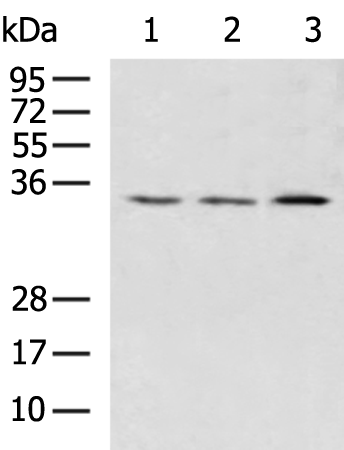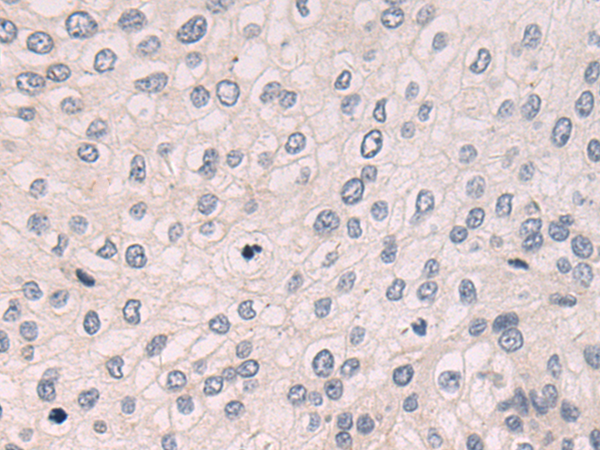

| WB | 咨询技术 | Human,Mouse,Rat |
| IF | 咨询技术 | Human,Mouse,Rat |
| IHC | 1/50-1/100 | Human,Mouse,Rat |
| ICC | 技术咨询 | Human,Mouse,Rat |
| FCM | 咨询技术 | Human,Mouse,Rat |
| Elisa | 1/5000-1/10000 | Human,Mouse,Rat |
| Aliases | SCDR9; NIIL497; SDR16C3; HMFN0376 |
| WB Predicted band size | 34 kDa |
| Host/Isotype | Rabbit IgG |
| Antibody Type | Primary antibody |
| Storage | Store at 4°C short term. Aliquot and store at -20°C long term. Avoid freeze/thaw cycles. |
| Species Reactivity | Human, Rat |
| Immunogen | Fusion protein of human HSD17B13 |
| Formulation | Purified antibody in PBS with 0.05% sodium azide and 50% glycerol. |
+ +
以下是关于HSD17B13抗体的3篇参考文献及其摘要概括:
---
1. **文献名称**: *HSD17B13: A Potential Therapeutic Target for Nonalcoholic Steatohepatitis*
**作者**: Abul-Husn NS et al.
**摘要**: 该研究通过免疫组化和Western blot分析,使用特异性HSD17B13抗体,发现HSD17B13蛋白在非酒精性脂肪性肝炎(NASH)患者肝组织中显著高表达。研究表明,抑制HSD17B13可能减轻肝脏脂质堆积和炎症,提示其作为治疗靶点的潜力。
2. **文献名称**: *Characterization of HSD17B13 Isoforms in Human Liver Using Monoclonal Antibodies*
**作者**: Yang J et al.
**摘要**: 作者开发了针对HSD17B13不同异构体的单克隆抗体,验证了其在肝细胞中的亚细胞定位(主要位于脂滴)。研究揭示了HSD17B13的剪接变异体在脂代谢中的差异功能,为疾病机制研究提供了工具。
3. **文献名称**: *Association of HSD17B13 rs72613567 Genotype with Hepatic Protein Expression*
**作者**: Kozlitina J et al.
**摘要**: 通过免疫荧光和质谱分析,结合HSD17B13抗体检测,发现HSD17B13基因rs72613567变异导致蛋白截短,显著降低肝脏中HSD17B13表达水平,并与酒精性肝病风险降低相关,强调了其遗传保护作用。
---
以上文献均聚焦于HSD17B13蛋白在肝脏疾病中的功能及检测方法,抗体应用涵盖表达分析、亚型鉴定及遗传关联研究。如需具体文献链接或补充,可进一步提供方向。
HSD17B13 (17β-hydroxysteroid dehydrogenase 13) is a liver-enriched protein belonging to the hydroxysteroid dehydrogenase family, primarily localized to lipid droplets in hepatocytes. It has gained significant attention due to its potential role in lipid metabolism and association with liver diseases, particularly non-alcoholic fatty liver disease (NAFLD) and non-alcoholic steatohepatitis (NASH). Genetic studies revealed that loss-of-function variants in the HSD17B13 gene correlate with reduced risk of progressive liver injury, positioning it as a therapeutic target.
HSD17B13 antibodies are essential tools for detecting and characterizing this protein in research. They enable the study of its expression patterns, subcellular localization, and interaction partners. Commercially available antibodies are typically developed using immunogenic peptides or recombinant protein fragments, validated through techniques like Western blot, immunohistochemistry (IHC), and immunofluorescence (IF). Specificity is often confirmed using HSD17B13 knockout cell lines or tissues.
These antibodies have facilitated discoveries linking HSD17B13 to lipid droplet regulation and inflammatory responses. Recent studies also explore its enzymatic activity in metabolizing bioactive lipids, potentially influencing disease pathways. As drug development targeting HSD17B13 advances (e.g., RNAi therapies), high-quality antibodies remain crucial for preclinical validation and mechanistic studies.
×